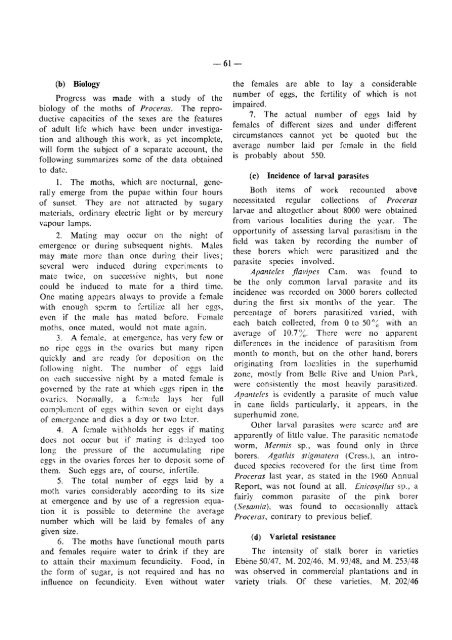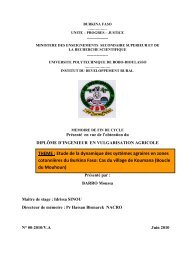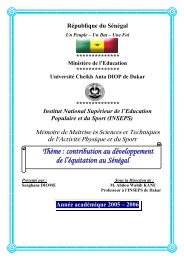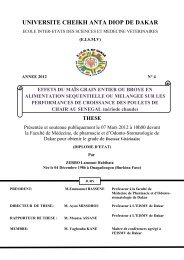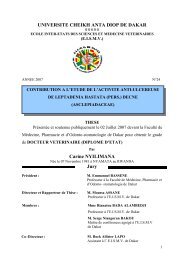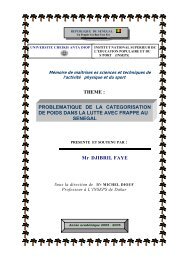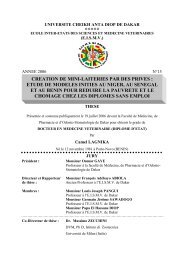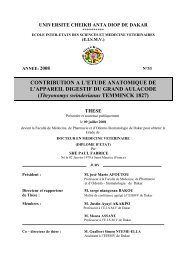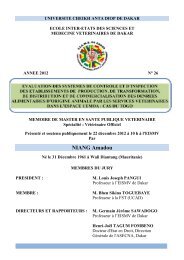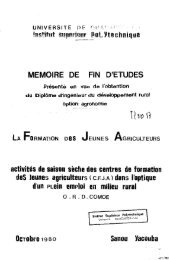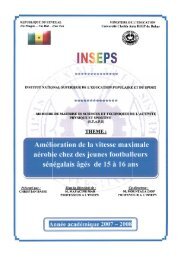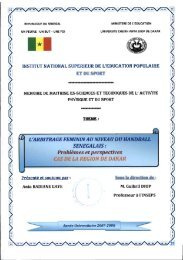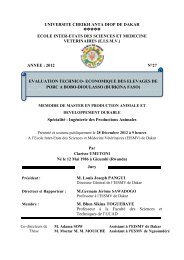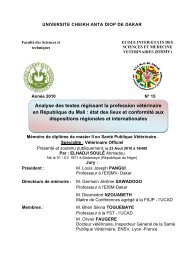Annual Report 1961 - BEEP
Annual Report 1961 - BEEP
Annual Report 1961 - BEEP
- No tags were found...
Create successful ePaper yourself
Turn your PDF publications into a flip-book with our unique Google optimized e-Paper software.
-61-(b)BiologyProgress was made with a study of thebiology of the moths of Proceras. The reproductivecapacities of the sexes are the featuresof adult life which have been under investigationand although this work, as yet incomplete,will form the su bject of a separate account, thefollowing summarizes some of the data obtainedto date.I. The moths, which are nocturnal, generallyemerge from the pupae within four hoursof sunset. They are not attracted by sugarymaterials, ordinary electric light or by mercuryvapour lamps.2. Mating may occur on the night ofemergence or during subsequent nights. Malesmay mate more than once during their lives;several were induced during experiments tomate twice, on successive nights, but nonecould be induced to mate for a third time,One mating appears always to provide a femalewith enough sperm to fertilize all her eggs,even if the male has mated before. Femalemoths, once melted, would not mate again.3. A female. at emergence, has very few orno ripe eggs in the ovaries but many ripenquickly and are ready for deposition on thefollowing night. The number of cccs=-=oneach successive night by a mated female islaidgoverned by the rate at whieh eggs ripen in theovaries. Normally, a female lays her fullcomplement of eggs within seven or eight daysof emergence and dies a day or two later.4. A female withholds her eggs if matingdoes not occur but if mating is delayed toolong the pressure of the accumulating ripeeggs in the ovaries forces her to deposit some ofthem. Such eggs are, of course, infertile.5. The total number of eggs laid by amoth varies considerably according to its sizeat emergence and by use of a regression equationit is possible to determine the avcrazenumber which will be laid by females of anygiven size.6. The moths have functional mouth partsand females require water to drink if they areto attain their maximum fecundicity. Food, inthe form of sugar, is not required and has noinfluence on fecundicity. Even without waterthe females are able to lay a considerablenumber of eggs, the fertility of which is notimpaired.7. The actual number of eggs laid byfemales of different sizes and under differentcircumstances cannot yet be quoted but theaverage number laid per female in the fieldis probably about 550.(c)Incidence of larval parasitesBoth items of work recounted abovenecessitated regular collections of Proceraslarvae and altogether about 8000 were obtainedfrom various localities during the year. Theopportunity of assessing larval parasitism in thefield was taken by recording thc number ofthese borers which were parasitized and theparasite species involved.Apanteles flavipes Cam. was found tobe the only common larval parasite and itsincidence was recorded on 3000 borers collectedduring the first six months of the year. Thepercentage of borers parasitized varied, witheach batch collected, from 0 to 50 o~ with anaverage of I0.7/~. There were no apparentdifferences in the incidence of parasitism frommonth to month, but on the other hand, borersoriginating from localities in the superhumidzone, mostly from Bclle Rive and Union Park,were consistently the most heavily parasitized.Apantelcs is evidently a parasite of much valuein cane fields particularly, it appears, in thesuperhumid zone.Other larval parasites were scarce and areapparently of little value. The parasitic nematodeworm, Mermis sp., was found only in threeborers. Agathis stigmatera (Cress.), an introducedspecies recovered for the first time fromProceras last year, as stated in the 1960 <strong>Annual</strong><strong>Report</strong>, was not found at all. Enicospilus sp., afairly common parasite of the pink boreriSesamiai, was found to occasionally attackProceras, contrary to previous belief.(d)Varietal resistanceThe intensity of stalk borer in varietiesEbene 50/47, M.202/46, M.93/48, and M. 253/48was observed in commereial plantations and invariety trials. Of these varieties. M. 202/46


